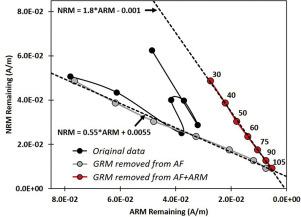Physics of the Earth and Planetary Interiors ( IF 2.4 ) Pub Date : 2021-07-06 , DOI: 10.1016/j.pepi.2021.106769 David Finn 1, 2 , Stuart Gilder 3 , Robert Coe 2 , Andrew Pike 4

|
Anhysteretic remanent magnetization (ARM) data serve many applications in the geosciences, such as quantifying the paleomagnetic field intensity, the magnetic grain size distributions in rocks, the degree of particle alignment from flow processes, and the emplacement and strain histories of rocks. However, the use of an alternating field when imparting or removing an ARM may give rise to a gyroremanent magnetization (GRM), which is a spurious signal that can bias ARM data. In this paper, we demonstrate the effect of GRM on ARM acquisition and demagnetization through an example of a relative paleointensity measurement. We describe a method using singular spectrum analysis to remove GRM acquired during static alternating field demagnetization (GRMAF). Another GRM component (GRMARM) is acquired during ARM acquisition. GRMARM is progressively removed during AF demagnetization, which results in a demagnetization spectrum containing two overlapping components (ARM and GRMARM). A second progressive demagnetization of a GRM imparted on the sample using an AF protocol with the same peak field as that used to impart the ARM, should contain the identical GRMARM component as acquired during the original ARM demagnetization. When separately measured, GRMARM can be subtracted from the original ARM demagnetization as a means of isolating a GRM-free ARM. Although we restrict our discussion to relative paleointensity, the methods described herein are applicable to any study involving alternating fields in paleomagnetic laboratory experiments.
中文翻译:

陀螺仪对适用于熔凝岩的相对古强度估计的影响
非滞回剩磁 (ARM) 数据在地球科学中有许多应用,例如量化古磁场强度、岩石中的磁性粒度分布、流动过程中的颗粒排列程度以及岩石的侵位和应变历史。然而,在施加或移除 ARM 时使用交变场可能会产生回转剩余磁化 (GRM),这是一种会使 ARM 数据产生偏差的虚假信号。在本文中,我们通过一个相对古强度测量的例子来证明 GRM 对 ARM 采集和退磁的影响。我们描述了一种使用奇异谱分析去除静态交变磁场退磁 (GRM AF )期间获得的 GRM 的方法。另一个 GRM 组件(GRM ARM) 在 ARM 获取期间获取。GRM ARM在 AF 退磁过程中逐渐去除,这导致退磁频谱包含两个重叠分量(ARM 和 GRM ARM)。使用具有与用于赋予 ARM 的峰值场相同的峰场的 AF 协议赋予样品的 GRM 的第二次渐进退磁应包含与原始 ARM 退磁期间获得的相同的 GRM ARM分量。单独测量时,GRM ARM可以从原始 ARM 退磁中减去,作为隔离无 GRM ARM 的一种手段。尽管我们将讨论限制在相对古强度上,但本文描述的方法适用于任何涉及古地磁实验室实验中的交变场的研究。











































 京公网安备 11010802027423号
京公网安备 11010802027423号